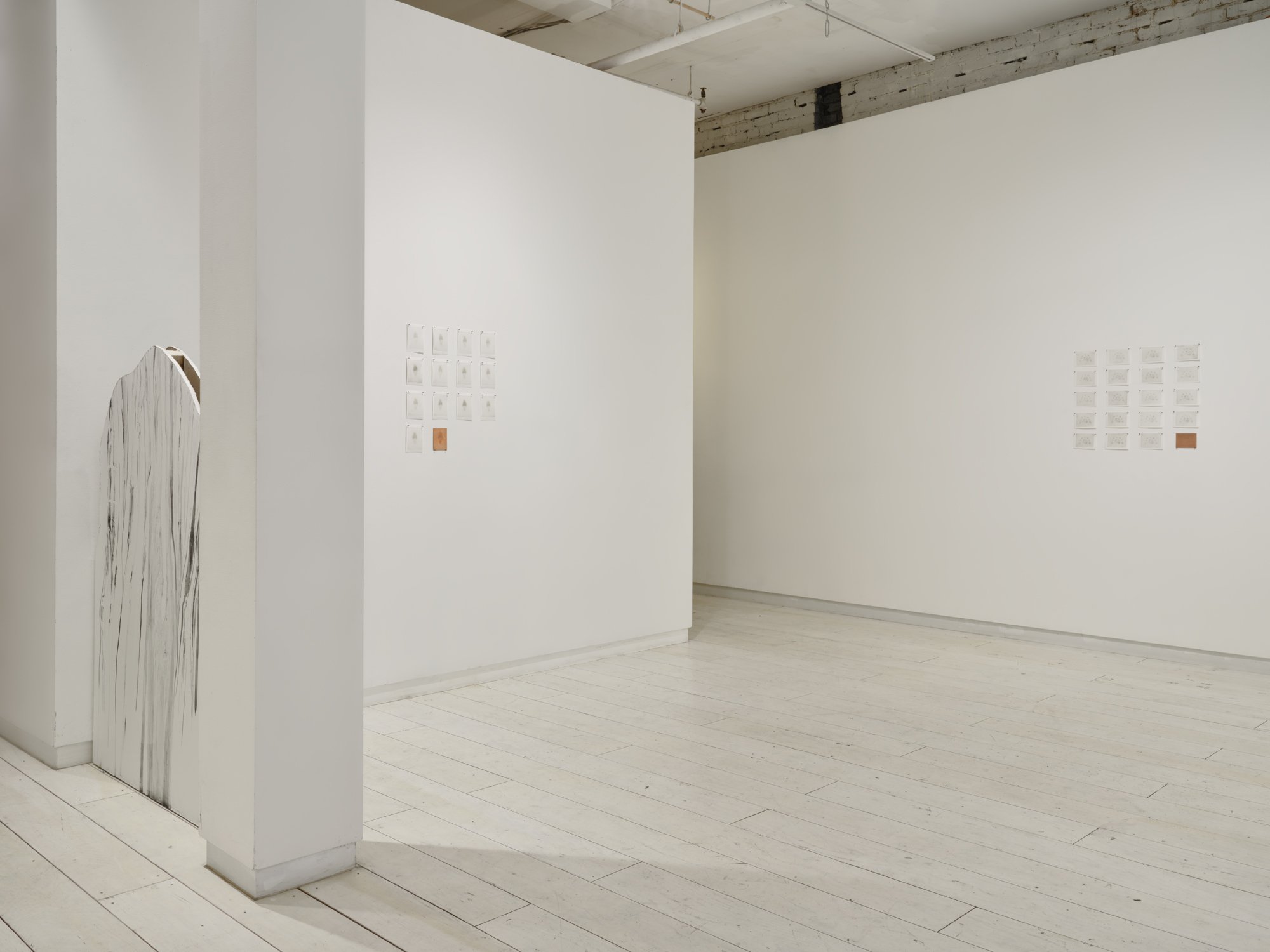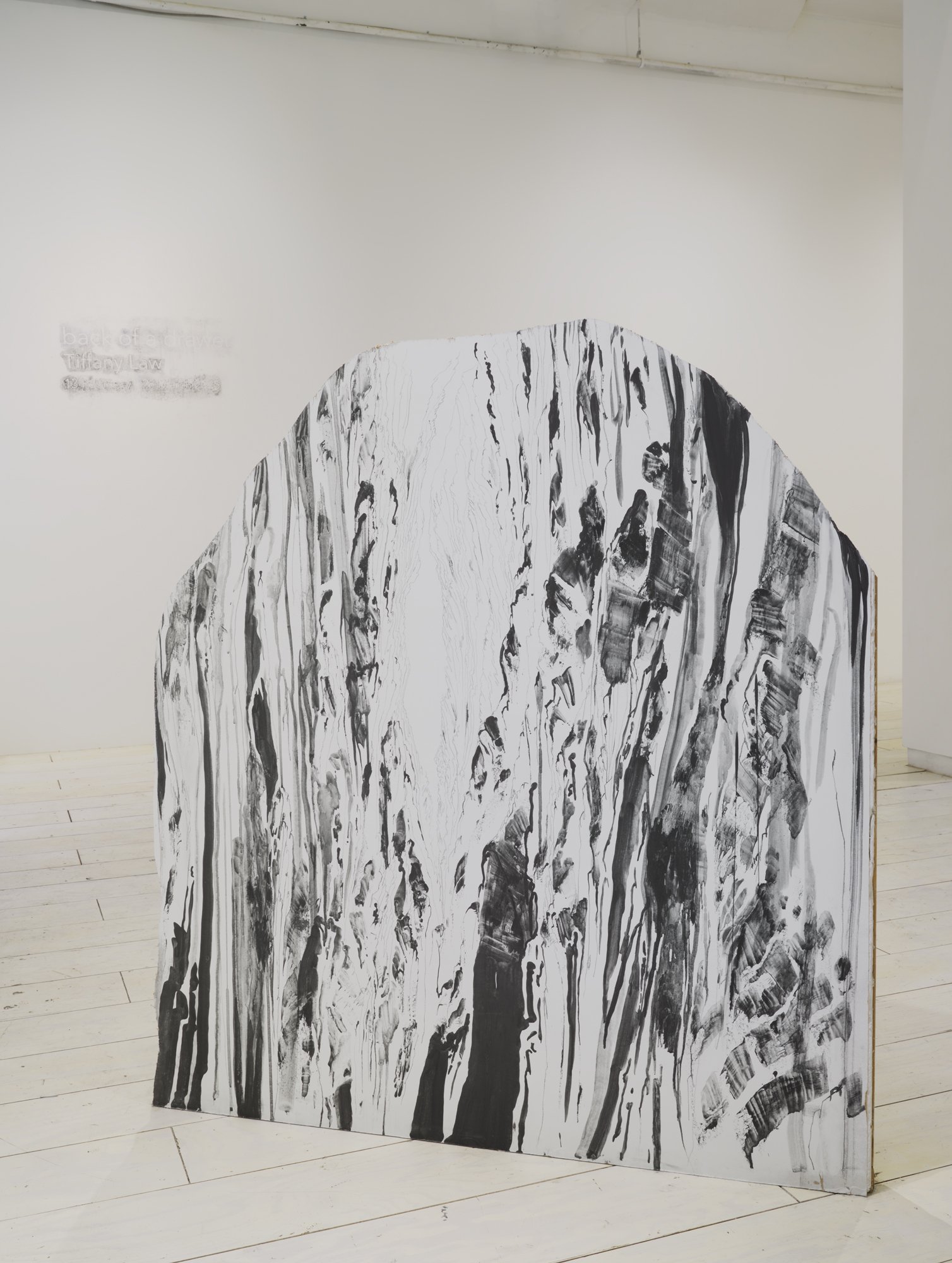back of a drawer
2025
back of a drawer presents a suite of new and reworked pieces, including drawings, intaglio prints, and sculptural drawings that allude to Law’s fascination with geological time, land formation, and the kinship between the body and non-human entities in the material world. Depicting caves, voids, and ruptures, these works evoke poetic and metaphorical journeys—an exploration both above and underground, tracing transitional, non-linear pathways of formation and being.
In this exhibition, Law examines the physical properties of the matters she has worked closely with. Through the cyclical and labour-intensive drawing and printmaking processes, graphite, paper, gypsum panel, copper plate, and rock gradually reveal their interiority as they transform, decompose, and reconstitute—constructing a reciprocal structure between image and material. The pictorial space becomes a palimpsest, a constellation of traces, erasures, and fragmented temporalities. Much like sediment compacting into rock, each mark is a grain of sand, a stratigraphic layer within the totality of the drawing.
*
《畫之後》展示了一系列新作及重作作品,包括繪畫、凹版印刷及雕塑畫作,箇中隱含吸引着羅氏的地質時間、土地形成,以及物質世界中肉體與非人類實體之間的親緣關係。藉着對洞穴、虛空與撕裂的描繪,這些作品喚起一次詩意且富隱喻的旅程——一場從地面延伸至地底的探索,沿途追溯着形成與存在的過渡性及非線性。
是次展覽中,羅氏對她恆常使用的物料從物理特性上展開實驗。透過循環與勞動性密集的繪畫及版畫處理過程,石墨、紙張、石膏板、銅板和岩石在轉化、分解與重組中逐漸顯現它們的內在性——構成圖像和物料之間的相互結構。畫面空間成為了一個積累痕跡、消耗和間段時間性的重寫本。就像沉積物積壓成岩石一樣,每個記痕都是一顆沙,一層在繪畫整體中的積沉。
[Text translated by Sami Lee.]
installation image courtesy to Rachel Topham Photography
mouth of death water
graphite, eraser dust, Canadian one-dollar coin, six tongues, gypsum panel
101 x 130 x 6 inches (243 x 335 x 5 cm)
slippery pool of time
mineral lubricant oil and graphite on paper
96 x 76 inches (244 x 447 cm)
printing a rock is an archive of its loss: copper on copper
copper ore-pigmented intaglio print and printing plate
edition of 11, 13 and 19 prints
3.5 x 5 inches each (8.9 x 12.7 cm)
printing a rock is an archive of its loss is an ongoing series in which I explore printmaking as a process that constantly unfolds and enfolds a body-time and material relationship. Through the cyclical and labour-intensive printmaking processes, the materiality of copper, rocks, and paper gradually reveals its interiority as it transforms, decomposes, and reconstitutes, constructing a reciprocal structure between image and material. This series of prints explores repetition and singularity, and embraces the state of “lost/loss” in the etching processes. In "copper on copper", the prints contain the seeds of their production. This work began with a visit to a 100-year-old defunct copper mine, and the number of prints is determined by the quantity of copper ores found and the ink it could yield from the rocks. The etched images on the three sets of prints are drawings of the copper ore drawn before a mortar crushes them to make printing ink. Printing with a matter with its weight and depth, the rock fragments scratch and mark traces on the printing plate, disrupting the etched imagery and carrying these traces to subsequent prints. While the printing press further pulverises them, each edition is the emergence of repetition and singularity of the drawn image. The printmaking process becomes an apparatus in which it is an archive of the loss of the rock, but simultaneously a “forming” of the rock from its sediments.
incarnated sediments
graphite on gypsum panel
46 x 59 inches, 47 x 48 inches, 45 x 51 inches
they are cutouts from the previous series, sentimentary formations (2024)
sanding the mudded passages
graphite on paper and drywall compound
dimension variable
Excerpt from essay written by Kitt Peacock <On Sedimentation>
A month passes before our paths cross again. T. is tending to her graphite pools, which she swirls and drains on two slabs of drywall (twelve feet wide, one half inch thick, thoroughly banged at the corners in the delivery truck). She is crouched over the pools like Odysseus over a pool of dark sheep’s blood, which granted the ghosts of his loved ones the power to speak with the living. T.’s pools evaporate before ghosts can gather. They dry down to holes and caves and crevasses. The image enfolds its own absence. It is dark and low like a graphite deposit, as cavernously empty as a mountainside stripped of gypsum. T. traces the edges of each pool with broken lines, as if stitching two sides of a wound. She folds the underworld up neatly, and places it to the side.
There is a stain on T.’s sweater as she packs up to leave that night. I recognize the grief-loss in the halo of graphite. It is as if we are out on the sand again, as if the edge of her sleeve found the edge of the water while she wasn’t looking. As if something reached out from the abyss to mark her, and say: we are coming back for this one.















